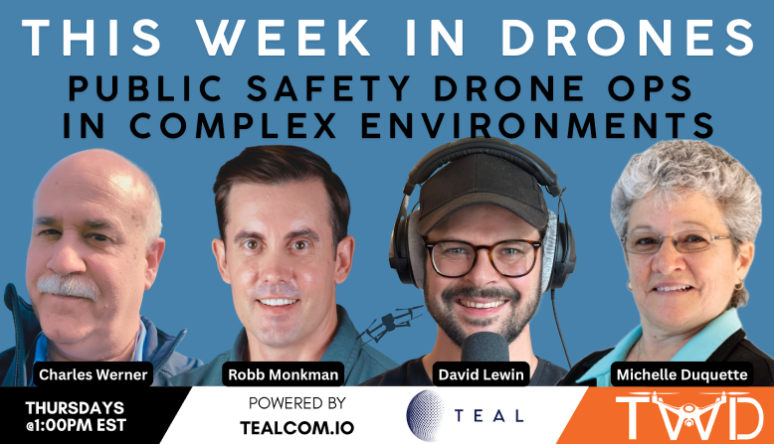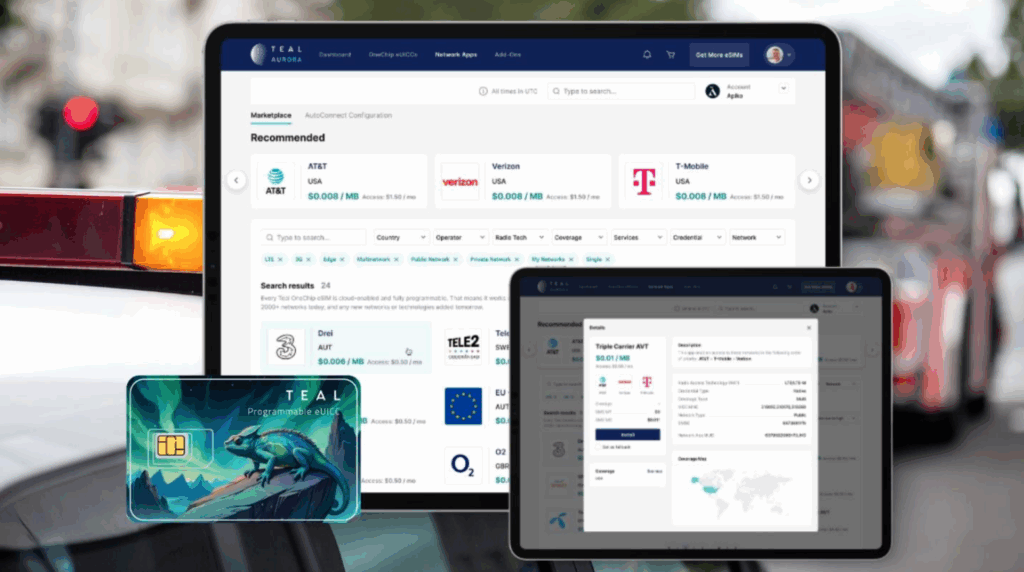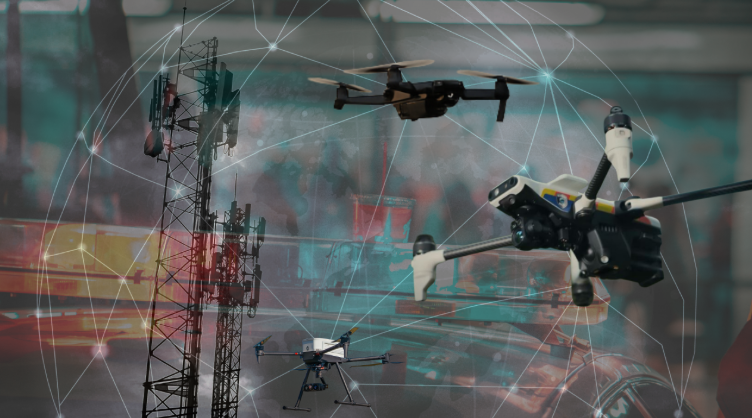By: Michelle Duquette (CEO, 3 MAD Air) & David Lewin (Host, This Week in Drones)
Federal policy for drone operations is at a crossroads. As Congress debates new authorities under the Counter-Unmanned Aircraft Systems (Counter-UAS) Authority Security, Safety, and Reauthorization Act, voices from the recent “This Week in Drones” podcast underscore why public safety agencies, including law enforcement, fire and emergency responders, need dedicated and dynamic rules and technological capabilities that reflect the urgency and unpredictability of local emergencies. Decision-makers have an opportunity to turn to their circle of advisors, truly understand the unique demands of public safety, including the need for infrastructure funding, and act with greater boldness.

Public Safety: Distinct Mission, Independent Voice
David Lewin set the stage for the discussion. “We’re here to create meaningful conversation and progress the drone industry in general, integrating drones in the national airspace, but also the counter-drone side: what about the drones that are not supposed to be there, and how do we deal with that and navigate and understand everything that’s in the airspace?”
Michelle Duquette outlined the challenge in trying to assimilate public safety into regulatory structures that Congress is still creating for the defense, national security and commercial operational communities. “It’s a square peg, round hole situation,” she said. “Public safety has enough nuances in its tactical and dynamic environment. We really need to start respecting those nuances and looking at them as an independent voice.”
Unlike the Department of Defense (DoD) and Department of Homeland Security (DHS), which operate missions based on national policy with strategic timelines, public safety agencies must respond in minutes to unpredictable crises. Their drones pursue suspects, monitor hazards, deter criminal activity and manage crowds at infrastructure sites or major events. These missions require frameworks suited to rapid deployment and dynamic decision-making.
Counter-UAS Legislation: Progress and Gaps
Legislative authority for counter-UAS (c-UAS) remains incremental, restricted to a handful of agencies, events and sites. Federal agencies, such as the DHS, FAA and Department of Justice (DoJ), hold most control. Applications and compliance add significant delay. For urgent drone emergencies, these roadblocks lead to real-world risks.
The latest House bill makes notable steps in supporting the public safety community’s unique needs in this arena. Highlights include:
- Public Safety Pilot Programs – These would allow state and local law enforcement agencies to deploy approved detection and mitigation systems with federal oversight at key sites and events (§§ 6105 and 6106).
- Robust Processes – Agencies would need to demonstrate direct threat, create site-specific safety plans, secure federal agreements and comply with ongoing reviews.
- Event-Specific Short-Term Authority – Major gatherings like World Cup or Olympics receive event-specific short-term authority, contingent on federal approval and evaluation (§ 6106j).
Even so, Chief Charles Werner, DRONERESPONDERS, cautioned that House authors don’t appear to be aware of progress the Federal Aviation Administration (FAA) and public safety have made. He noted, “… (This language was) written probably two years ago and it didn’t evolve with the things that have happened so quickly here recently.”
For example, Don Redmond, BRINC, pointed out that there should be some designation to allow public safety the right of way in the air. “Being able to carve out an airspace that public safety can utilize is really important for safety for everybody,” he noted.
The Importance of Dedicated Infrastructure: Reliable Connectivity

Moving from c-UAS legal matters to infrastructure, the TWID panel highlighted that for mission-critical drone operations, reliable connectivity isn’t optional, it’s essential. Public safety drones must stay in constant contact with ground control, transmit data in real-time, and respond to commands instantly. Any disruption could mean mission failure, or worse, accidents.
Robb Monkman, Chief Marketing Officer at TEAL, explained, “Connectivity can be one of these big hurdles to completing the mission. For us, it’s really about failover and redundancy.” That’s why having multiple forms of connectivity including cellular, RF, and in some areas, satellite, is critical.
Monkman continued, “If you think about a big city like Seattle or New York, and there are tall buildings, there are other obstacles. RF can be blocked and can be jammed. You need to make sure that your drone operations can continue, especially if it’s mission critical.”
Beyond visual line of sight (BVLOS) drones need low-latency, high-throughput connectivity, especially in urban and suburban areas. TEAL’s Network Orchestration Service (NOS) ensures mission success by providing seamless access to tier-1 networks in 196 countries, automatic failover and dynamic, over-the-air carrier switching for ultimate redundancy.
Beyond Federal Norms: Building Public Trust
Getting the tech right – whether c-UAS or communications networks – isn’t the only step. It’s just as critical to go to the communities being served.
Drones act as both efficiency tools and as protection against nefarious drones. Federal processes cannot keep up with street-level realities or serve as substitutes for proactive, local expertise. It all has to function without fail within the same system of systems. And community engagement is key. The TWID panel outlined a few pointers to score points with the community:
- Ask for their help shaping policy and procedures
- Ensure their concerns are heard, especially regarding civil liberty
- Create a program that protects them in ways they agree to.
Duquette referred back to Chief Werner’s warning and flagged the importance of public trust. “If you don’t start your community engagement program first, before you start deploying your public safety drones, you are on a path to failure. All that’s going to do is cause confusion and delay the successes and the benefits that you will ultimately gain through your drone program.”
Final Thoughts: Build a Permanent, Distinct Regulatory Path for Public Safety Now
Every second matters in public safety response. To defend and serve communities, Congress and federal agencies must empower these SLTT officials as full partners in securing American low altitude airspace.
While the new act recognizes public safety as a stakeholder, it leaves emergency authority subject to federal approval and sunset clauses. Congress and agencies must go further and build a distinct, permanent Public Safety c-UAS policy track that:
- Grants streamlined authority for State, Local, Tribal, and Territorial (SLTT) agencies to deploy detection and mitigation without lengthy federal review.
- Provides airspace prioritization so Public Safety drones have procedural and technological right-of-way during emergencies.
- Supports robust training, infrastructure and funding models for all agencies protecting vital assets and infrastructure, not just major airports.
- Requires continued safeguards in terms of transparency, privacy and active community engagement.
- Embeds Public Safety representation in policy development for spectrum, Remote Identification, detect-and-avoid, and related technologies, using their daily operational expertise.
The time for incremental experiments has passed. We have meaningful intelligence from real-time experts, an American public that knows how it wants to be protected, the technology is ready and the legislative framework is there. Let’s act now to build a smart, rapid policy for Public Safety.
* Sponsored content. Discover how TEAL can help to ensure mission success with always-on, redundant cellular connectivity. Get the flexibility and control to remotely switch between cellular networks, ensuring the highest level of reliability and performance for your drone operations and contact the sponsor for this TWID podcast episode.

